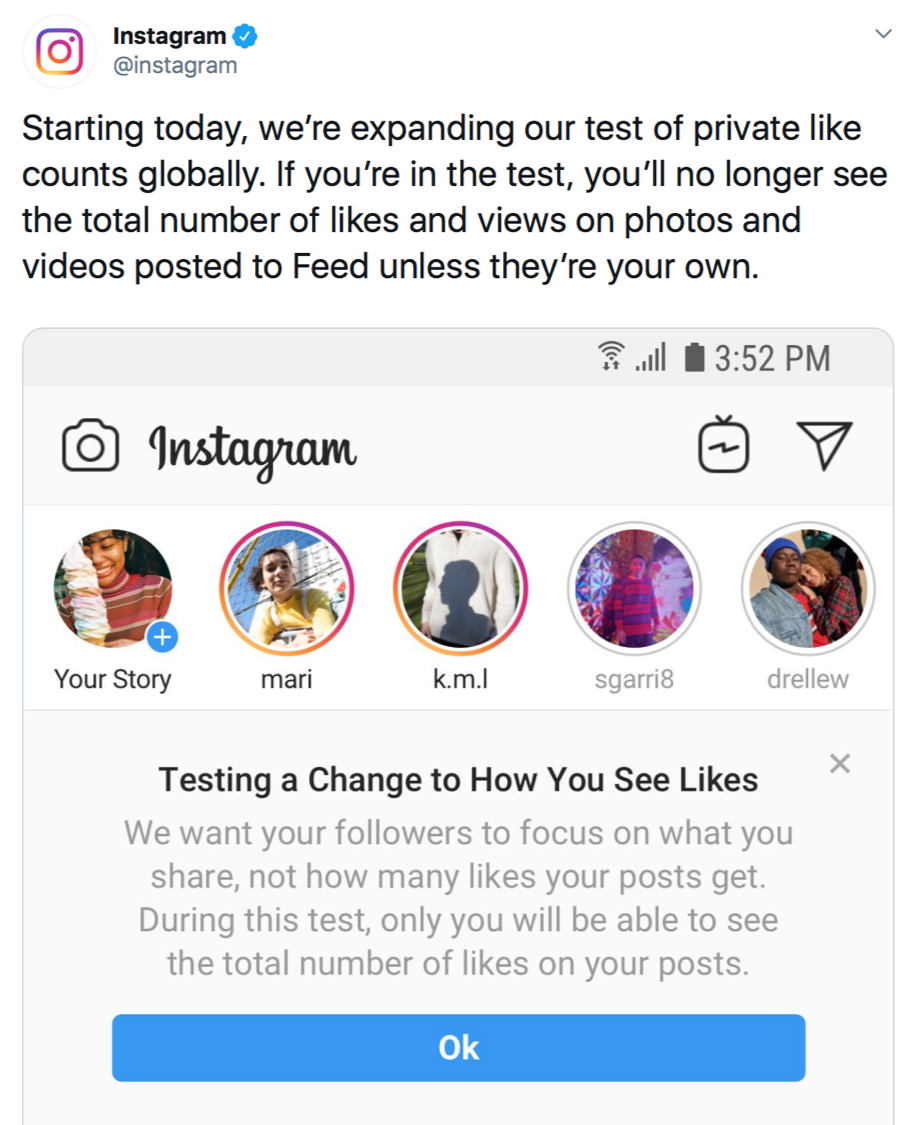Instagram announced this month that after a small test of removing visible “likes” from public posts, the company will expand the change to U.S. users.
The news came from head of Instagram Adam Mosseri (@mosseri) via a tweet that read, “Heads up! We’ve been testing making likes private on Instagram in a number of countries this year. We’re expanding those tests to include a small portion of people in the U.S. next week. Looking forward to the feedback!”

Then, within the week, Instagram blasted the news on their own Twitter account as well, saying they’re enacting the change globally.

The Impact on Business Marketing
So do we like the change? Or not?
Well, it’s complicated.
According to Instagram, the change should help users refocus on quality of content instead of “how many likes” posts can amass. The implication is that public “likes” may be more indicative of popularity and less of value. In essence, it’s a popularity contest.
Still, the fact remains that both brands and individuals have used Instagram’s public liking feature as a quick and dirty way to measure their Instagram marketing success. After all, it makes sense that posts which get a high volume of “likes” have reached a good number of consumers. And, those consumers reacted favorably to the content.
But there’s a deeper story here. While the change will change how marketers use Instagram to promote their businesses, hiding “likes” isn’t necessarily all bad.
Smarter Partnerships
This change seems to most heavily impact Instagram influencers — people whose individual accounts reach enough users that brands are willing to pay for their public endorsements. Since most influencers quantify their value to advertisers with Instagram’s own metrics, disallowing users to “like” posts could, in theory, hurt influencers’ ability to prove their marketing worth.
But just because Instagram is removing public visibility of “likes” doesn’t mean they’re removing users’ ability to quantify success. Users will still be able to view likes privately, and they’ll still have access to plenty of other engagement metrics.
Though the change might make it harder for the beginner influencer to break into the game, it should also guide advertisers and influencers to think of engagement more broadly — to look beyond the “likes” to develop smarter partnerships.
More Meaningful Engagement
So if it’s not “likes” that matter most, what other engagement metrics are there?
Tons.
Take a deep breath, because the engagement metrics we’ve always had access to are still available. Comments, shares, saves, followers, clicks and conversions are easy to see and even easier to quantify with various Instagram marketing plugins and software tools. They just won’t be publicly visible any longer.
Business marketers can use these engagement metrics to consider what they value most in influencers.
Would you rather partner with someone who boasts a massive following? Or would a partner with a smaller, more loyal and engaged network get your brand in front of the right users?
It’s now on small businesses to dive deeper into engagement and make these decisions.
Creative, Compelling Content
Many think the change will affect more than how marketers measure success on Instagram. The removal of public “likes” should also force content creators to up the ante.
Think about it this way. If Instagram account owners can no longer rely on hundreds of little hearts to help their posts pop out of the feeds, they have to find better ways to stand out.
So, it’s back to basics. Creative, compelling pictures and video should win out. Bring on the filters, effects and creative camera angles!
More Money toward Instagram Ads
More cynical marketers may see Instagram’s move to remove “likes” as a selfish play to take back control of the advertising dollars businesses spend on the Facebook-owned social media channel.
Removing “likes” could make it harder for brands to see the correlation between money they pay influencers and resulting sales. Without that easy-to-see return on investment (ROI), it’ll be harder to justify paying influencers such large sums of money. Instead, brands may choose to refocus on Instagram ads which offer a more transparent ROI.
Basically, if it’s harder to be sure influencers are helping you sell more, ads might be the right option. And if your business buys more ads, Instagram makes more money.






